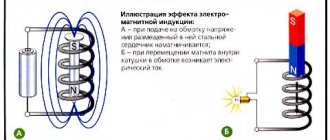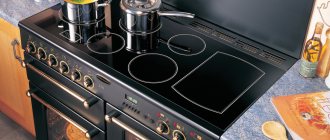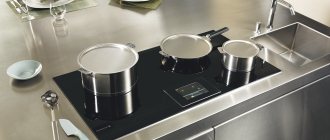Infrared cooker
An infrared cooker is a heating equipment designed for cooking food. Heating occurs using heating elements , which produce infrared radiation passing through the glass-ceramic surface.
The use of such equipment will allow you to prepare first and second courses in a short time. Food cooked using an infrared cooker will have a golden brown, crispy and golden crust.
Most IR plates consist of the following elements:
- Frame.
- Glass ceramic surface.
- Heating component.
- Control block.
- Cooking area.
The principle of operation is to heat up the heating component , after which the dishes placed on the surface are heated and the food in them is cooked.
The infrared stove can be purchased in a tabletop or floor-standing version, or it can be built-in. In the second and third cases, it is possible to install an oven. Each model is equipped with one burner, and the maximum number of burners is 4.
Infrared or induction cooker: comparison and which is better to choose – Website about
Infrared cookers are very popular among Russian consumers. Many of these models are universal: they can be used both for cooking and for heating rooms. Let's consider the characteristics and features of infrared cookers, recommendations for their use, as well as their main differences from induction devices.
The functioning of infrared cookers is ensured by heating elements. With their help, infrared radiation is created through the glass-ceramic work surface. It is absorbed by the water in the food.
As a result, a lot of heat is generated, causing the stove to become hot after some time. With the help of such devices, food is prepared in the shortest possible time.
Glass-ceramic materials are used as working surfaces in infrared cookers, which have a large number of advantages.
They conduct heat well and are very resistant to high temperatures. Another important advantage of infrared cookers is their high heating rate.
It is also worth noting that you can easily set the optimal temperature (from minimum to maximum high).
Glass-ceramic worktops are very easy to use and clean, and they are also highly durable. They can be used to create a wide variety of dishes. Infrared cookers are especially often used for preparing baked goods, various fish and meat dishes.
Infrared cookers can be placed on a table or on the floor. Some devices have an oven. Infrared cookers have several burners: from 2 to 4. Tabletop appliances are compact, lightweight, and mobile. A portable infrared stove can be used as a tourist or camping stove.
The surface of the device is covered with enamel, glass ceramics or made of metal (stainless steel). Metal models are characterized by increased resistance to mechanical stress, while glass-ceramic models are more resistant to temperature fluctuations. Enamel also has the above advantages, but at the same time it is also quite affordable.
Induction cookers operate using electromagnetic coils. When electricity is supplied, a magnetic field is created around them. Such stoves heat only special dishes (usual ones should not be used for such devices), while infrared stoves heat everything around: the surface of the device, the composition of the food and the air.
When deciding which infrared cooker to purchase, you should first decide on the size of the device. It depends on how much food will need to be prepared, as well as how large or small the room will be.
It is better to purchase an appliance that includes an oven: in this case, you do not have to install the oven separately, and you can also save space in the kitchen.
Cookers with an oven are more expensive, but they have significantly more advantages.
The cost of infrared devices also depends on the material from which they are made. Metal devices are more expensive.
It is worth paying attention to the presence of various additional functions: built-in dirt removal, residual heat indicator, timer. Such functions will reduce the cooking time.
Glass-ceramic surfaces are resistant to temperature changes and are quite durable. However, such surfaces cannot be repaired, so if damaged, they must be completely replaced. If necessary, heating elements that emit infrared radiation can also be replaced with new ones, but it is better to entrust such work to experienced professionals.
When using an infrared device, it is better to take into account some recommendations. For example, you should be very careful when heating the device to high temperatures.
Some experts believe that radiation from infrared devices is not safe for the human body.
To reduce the risk of undesirable consequences, you should load the surface of the device in use to the maximum.
After finishing cooking, immediately turn off the stove (each section should be turned off). Avoid getting water on the stove, otherwise you may damage the device or get burned.
Some models of infrared devices are especially popular among consumers. They are distinguished by high quality and good performance characteristics. Let's look at some of them.
- Irida-22. This stove can be used in a country house, on a hike, and is a tabletop stove. Irida-22 is a two-burner stove, the power of the burners can be adjusted. The device operates using liquid gas contained in a cylinder. It is completely burned. The Irida-22 model is made of metal. The wind does not extinguish the flame of this stove, so it is very suitable for outdoor use.
- BW-1012. In addition to cooking, such a stove can be used to heat a room. It can be used in a country house, in an apartment, or on a hike. The burner of this infrared stove is ceramic; it does not emit any unpleasant odor or substances harmful to humans. One of the main advantages of this model is the ability to regulate the fire in the burner. It is distinguished by its reliability and long service life.
- Electrolux Libero DIC2 602077. Electric two-burner stove with glass-ceramic work surface. The electric stove is easily controlled using a digital display. This model is very often used in various cafes with average traffic, small restaurants, and catering establishments.
- CB55. This model can be used for heating while traveling and for cooking. It is suitable for use in summer kitchens and country houses. The burner is ceramic. Propane burns out completely, so it is used as economically as possible. The strength of the fire in the burner is smoothly adjustable; the device has piezo ignition. This model works well even in strong gusts of wind, and its body is made of steel coated with heat-resistant paint and varnish.
See the video below for testing the infrared cooker.
Source:
Induction cooker
An induction cooker is considered the safest in comparison with glass ceramics, pancakes and cast iron . Its functioning is based on electromagnetic induction. This principle is explained by the appearance of electric currents inside a closed loop, which arise when the flow passing through it changes. This phenomenon began to spread in the 19th century, and was discovered by the physicist M. Faraday . If we draw an analogy to an induction cooker, we can compare it to a portable transformer.
Induction in the hob occurs due to a coil that does the work of the winding. Electricity passes through it, reaching a frequency of 60 kHz . The secondary winding is installed on the panel, and its bottom receives the induced current. First of all, the dishes heat up, and then the heat transfers to what is located in it.
An induction hob cannot get too hot , which is due to its main feature; the bottom of the cookware heats up first.
This effect minimizes heat loss, and under its influence the dishes will become hot many times faster compared to gas and electric stoves.
Which stove is better - electric or induction?
Choosing a hob is one of those issues that both happy new residents and simply those whose old stove has become unusable have to decide.
Today, the choice is usually made between electric and induction hobs: gas stoves are also good in their own way, but many new buildings now don’t even have gas installed.
And this choice, for all its inevitability, is not too obvious. So which stove is better - electric or induction?..
I have long planned to write an article about the pros and cons of electric and induction hobs, but I wanted to do it from a practical point of view, which I now have every right to: for six years I cooked on an electric stove, which I recently replaced with an induction hob Pyramida IFEA 640 B, and now I can tell you about the advantages and disadvantages of both solutions from my own experience.
How is an induction cooker different from an electric cooker?
Before answering the question of which stove is better - induction or electric - let’s figure out how they differ. Let's start with electric hobs as the older ones.
Their principle of operation is quite simple: electric current passes through a resistor, which releases thermal energy, which, in turn, is transferred to the dishes placed on the heating element.
Modern electric stoves mainly have a surface made of glass ceramics, but in terms of their design they are not so far removed from the old electric stoves with metal burners.
An induction hob operates differently: under each burner there is a high-frequency generator that creates eddy induction currents in the metal cookware placed on the burner.
In this case, the cookware acts as a conductor, and it is it that heats up, and not the coil or the surface of the stove - provided that the cookware has conductive properties.
If all this doesn’t sound very clear to you, don’t worry about theory, let’s better find out what this means for us in practice.
So, let's compare induction and electric cookers on various parameters and then come up with the final score. For each indicator, both types of slabs will be awarded from 0 to 2 points, depending on how well they perform in one aspect or another.
Suitable cookware
The first thing I did when I became the proud owner of an induction cooker was to go to the store and buy an adapter, this steel pancake, which costs much more than you might expect by looking at its shape.
As mentioned above, an induction cooker is capable of heating only cookware that has ferromagnetic properties, of which there were surprisingly few of the pans and pots that served me faithfully.
The adapter is capable of turning an induction cooker into a regular electric one, heating up and transferring its heat to the cookware placed on it, but it deprives it of all the advantages that will be discussed below. If you place the wrong frying pan on the induction burner, it won’t even turn on.
To understand whether a cookware is suitable for an induction cooker, attach a magnet to it or simply turn it over; the following pictogram is usually placed on compatible cookware:
At first glance, electric stoves do not have this drawback, but in practice they are far from ideal.
An electric hob can only provide even heating if the cookware has a perfectly flat bottom, but even the most reliable pot or pan will warp over the years when exposed to intense heat.
For the same reason, it is inconvenient or simply impossible to cook on an electric stove, using a regular wok or cauldron with rounded walls and bottom, you will have to use utensils adapted specifically for electric hobs.
Induction hob – 0 points Electric hob – 1 point
Ease of use
The virtue you will need when using an electric stove is patience. The burner heats up quite quickly, almost instantly, but it takes time to transfer its heat to the cookware. A lot of time. It takes about 7 minutes to heat a frying pan to a temperature suitable for frying, and 15-20 minutes to bring a pot of water to a boil for pasta.
In order to change the temperature of already heated dishes, everything is also not easy - quickly increasing the “fire” from low to maximum simply will not work, and the most reliable way to quickly reduce the heat is to remove the dishes from the stove. Perhaps this is the most important disadvantage of an electric hob - it is slow, inert, and this makes it terribly inconvenient.
This is not the case with an induction hob. The source of heat in its case is the bottom of the cookware itself, so the increase or decrease in heating occurs literally instantly: if your previous stove was gas, you won’t even notice the difference.
I specifically conducted an experiment and recorded the time it took my Pyramida IFEA 640 B to bring 2 liters of water to a boil in a saucepan without a lid. It took 9.5 minutes - more than half as much time as I would have spent using an electric stove. In addition, the induction hob has other advantages arising from its operating principle.
Firstly, it is high efficiency - thermal energy does not go “into the air”, but is almost completely used to heat food.
Secondly, its efficiency - since almost all the energy is used for its intended purpose, an induction cooker, all other things being equal, consumes less electricity and costs you less. Considering that electric and induction hobs cost approximately the same, this is an extremely useful feature in these times.
Thirdly, the stove will automatically turn off if you remove the dishes from the burner, which also helps to save both natural resources and your money. In general, in terms of convenience, the induction hob deserves a solid five (which on our scale corresponds to a solid two).
Induction hob – 2 points Electric hob – 0 points
Noise
During its operation, the induction hob makes various sounds, which was a discovery for me, because the electric stove is absolutely silent. This cannot be said about induction; it crackles quietly, turns on a fan hidden in its depths to cool the coil and the transistor radiator, in a word, it lives its own life.
Do not in any way think that these sounds irritate, frighten or somehow interfere with my life, but they exist, and after the electric stove has not made the slightest sound for several years, this is surprising. To the credit of the induction cooker, I can assure you that these sounds are quite quiet, and you stop noticing them quite quickly.
Induction hob – 1 point Electric hob – 2 points
Heating the hob
The operating principle of an electric stove is that heat is transferred to the cookware by contact with a heated burner. In other words, an electric stove simply must be hot, heat up quickly and not cool down too quickly, which entails several not very pleasant consequences.
Firstly, such a stove poses a risk of burns, especially for children and pets, and also, albeit a moderate, but still a fire safety threat.
Secondly, as the stove cools down, it releases residual heat into the surrounding air, and if it happens in the hot summer, and you also don’t have air conditioning, you can imagine what an inferno the kitchen turns into when preparing several dishes at the same time.
Thirdly, any liquid, like sauce or soup, when dropped onto a heated burner, instantly turns into acrid smoke, leaving a hard-to-remove black stain on the surface. Of course, there is a wide selection of products on sale to combat such pollution, but the very fact of the appearance of unpleasant odors and additional headaches cannot be encouraging.
An induction hob is a different matter! As mentioned above, it does not heat itself, but generates heat directly in the cookware placed on it - and this alone creates a huge gap between electric and induction cookers.
Yes, an induction hob can get hot, but this will be from the heat of the cookware placed on it, and if you remove the pan from the stove, the hob will quickly cool down. There will be no burns, there will be no overheating of the air, and stains, if any, will be wiped off with much less difficulty.
In short, in terms of this parameter, an induction cooker is ahead of an electric cooker by a large margin.
Induction hob – 2 points Electric hob – 0 points
Verdict
Of course, I haven’t listed all the differences between induction and electric stoves, but I’ve listed the most basic ones, so it’s time to summarize. Let's calculate the points scored:
Induction hob – 5/8 Electric hob – 3/8
What does this mean? The fact that an electric hob is quite suitable for use, which I have proven from my own experience, and you can check for yourself, because 99% of the recipes from this site over the past 6 years have been prepared on an electric stove.
In turn, an induction cooker cannot be called ideal either - and if you can turn a blind eye to such a trifle as a little noise, then the incompatibility with a large number of otherwise good cookware is much more saddening. This means that technology has room to grow, and we can hope to see hobs and stoves without these shortcomings in the foreseeable future.
However, at the moment, an induction cooker is a thing of today, and an electric cooker is already yesterday. Does this mean that an induction cooker is definitely better than an electric one? I think I’m ready to answer this question in the affirmative, because the advantages of my new Pyramida stove outweigh its disadvantages, and there is no shortage of cookware suitable for induction stoves.
For those who managed to acquire their favorite cookware and do not want to send it to the dustbin of history along with the old stove, there are quite working solutions - the already mentioned adapter for induction cookers or combined hobs, some of the burners of which are conventional electric, and the rest work on induction principle. This will allow you not to part with your favorite dishes, but at the same time open the door to the future - since you are still afraid to open it wide open.
Source: https://arborio.ru/varochnaya-panel-elektricheskaya-ili-indukcionnaya/
Comparison and how they differ
Pros of an infrared cooker:
- The equipment does not consume much electricity if you heat the dish at a temperature of 60 degrees .
- After cooking is completed, the sensor lights up, indicating that the device has not yet cooled down.
- It does not take much time to prepare a dish compared to a gas stove.
- You can use the option to reduce the surface temperature at any time.
- Power level adjustment is available.
- Even a heavily soiled work surface can be easily washed.
- To control the cooking process, the stove is equipped with a monitor and timer.
- There are no harmful factors such as soot and carbon monoxide.
- There is protection against accidental changes and power surges.
- Any utensil except plastic, plastic and paper can be used.
Disadvantages of an infrared cooker:
- The glass-ceramic surface is very fragile and may be damaged during transportation. In this case, it cannot be repaired and requires complete replacement.
- If water is spilled on the device, it may impair its functionality. When it hits the surface, an unpleasant cracking sound occurs.
Pros of an induction cooker:
- Electricity is consumed 1.5 times less compared to an electric stove.
- After removing the cookware from the surface, the induction cooker turns off and cools down, which minimizes burns when touching the surface. There will also be no need to set aside a frying pan or pan if a recipe calls for it to be removed from the heat.
- The stove is easy to use and easy to care for after cooking due to the fact that the surface will not be hot. This advantage eliminates the formation of burnt food residues on it.
- The process of cooking and heating food is 3 times faster .
- There are several cooking modes that will allow you to use it for certain purposes. For example, you can slowly stew vegetables or quickly boil water.
- The appearance attracts attention.
- The burners have a smooth surface , they are easy to use, and it is easy to move any utensils on them.
Disadvantages of an induction cooker:
- High noise level causing discomfort.
- If the diameter of the cookware is less than 6 centimeters, then it does not heat up.
- The glass-ceramic surface is very fragile and requires careful handling.
Infrared tabletop stoves: pros and cons, rating of the best models
A tabletop stove is a lightweight and compact device; it is an excellent helper in small kitchens, cottages and other country houses.
Not so long ago, the main assistant for housewives in areas not provided with gas was only electric stoves. Nowadays, infrared tabletop cookers (IR) are in great demand.
Appearance and principle of operation of the IR plate
Heating in it occurs with the help of heating elements that generate infrared radiation, and heating is based on the fact that the water in the products absorbs this radiation. This generates large amounts of heat. This operating principle is the key to fast cooking. And it turns out with excellent taste characteristics and does not lose its beneficial qualities.
Many modifications of IR cookers for domestic purposes are equipped with a glass-ceramic surface. They are made up of: a housing, a heating component, a cooking platform and a control unit.
The heating component heats up and then heats up the cookware. These actions are provided by electric current.
The glass-ceramic surface is resistant to pressure and temperature changes. You can easily place massive dishes on it and set maximum heating parameters.
However, pinpoint impacts are dangerous for such a surface. Heavy objects should not be allowed to fall on it. It can be seriously damaged, for example, by a metal corkscrew or the edge of a saucepan lid.
This surface has excellent thermal conductivity. Therefore, the stove heats up to high levels very quickly. In household versions, the temperature limit is usually 300ºС. In professional ones - twice as much.
Thanks to the glass-ceramic panel you can:
- Reduce the absorbed power of the stove and the duration of its heating.
- Develop efficiency.
- Change temperatures quickly.
IR models allow you to prepare a variety of dishes: from soups to pancakes. You can purchase their desktop and floor-standing versions. The second ones may have ovens. Models are usually equipped with a minimum of one burner, and a maximum of four.
Also today, more preference has been given to infrared grills. There are modifications of small dimensions. They are often used on loggias, verandas and for summer cottages. There are professional variations that are commonly found in food service establishments.
They significantly speed up and improve the quality of service.
Its advantages are:
- Economical. Thanks to the use of this unit, electricity costs are significantly reduced. The duration of the culinary process is also radically reduced.
- There is an option to sharply reduce the temperature.
- The work panel is easy to clean.
- Many modifications have several power levels (maximum 10). When food is heated under conditions of no more than 60 degrees, there is almost no electricity wasted.
- The equipment includes timers and convenient monitors for control. Another option that is often found is a child lock.
- For such models, you can use any utensils (exceptions: paper, plastic and plastic). No need to purchase special utensils.
- There is a glowing “Hot” sensor. This is protection against accidental burns while the device cools down after use.
- Protection against voltage surges and surges has been installed.
- There is no open flame, soot or carbon monoxide.
Minuses:
- Considering that the glass-ceramic surface is quite vulnerable, the tiles must be transported and used extremely carefully. If the coating becomes damaged, it will need to be completely replaced.
- The device must not be filled with water. Of course, no one will do this on purpose. But it happens that water can leak from the pan. And water can disrupt the functionality of the device. And when water gets on the operating equipment, you hear a nasty crackling sound.
These disadvantages are quite arbitrary. And they do not negatively affect the impression of using such tiles.
Dilemma: induction or IR?
Today, the question of the advantages of an induction or infrared cooker is very relevant. It’s better to put it briefly: the first heats only the dishes placed on it. And certain utensils are required here. Such models work more economically. The second is everything that is placed on it. And if there is nothing standing on it, it can heat the air.
Therefore, if you need a good economical option and are ready to resolve issues with the availability of certain types of cookware, then you need an induction unit.
If the dynamics of heating and cooking are important to you, purchase tabletop IR cookers. It is important to follow certain criteria when purchasing.
Criterias of choice
The primary criterion is to choose based on the brand. It is better to concentrate on a famous manufacturer. And choose one or another modification taking into account your needs.
Other key criteria:
- Number of burners.
- Maximum heating rate.
- Is there a timer and additional options?
The price indicators of IR tiles are determined by the following factors:
- Case material.
- The quality of the heating component.
- Current options and functionality.
The most impressive price tags are observed for devices made of stainless steel. The cost of this equipment may increase when it contains additional options, for example:
- electronic type timer;
- sensor that reflects residual heat;
- Category A energy absorption programmers;
- self-cleaning technology.
The significant cost of IR tiles subsequently pays off, since electrical resources are significantly saved.
Principles of caring for this equipment
When using an IR stove, do not forget that it is still an electric unit. And it is subject to certain safety rules.
Before cleaning the stove, be sure to disconnect it from the electrical system. For this procedure, use only a soft sponge or cloth. Here you should also use liquid dishwashing detergent or a special preparation for cleaning this material – glass ceramics. The use of abrasive methods is prohibited. They have a detrimental effect on the appearance and quality of the surface.
Do not forget to periodically eliminate dust that accumulates in the ventilation grilles of the device. You can do it manually, or you can use a vacuum cleaner. Under no circumstances should you clean the tiles by completely immersing them in water.
When the IR model is used carefully and all recommendations for its use and care are followed, it will work for a very long time.
Examples of top models
Today you can find many different tabletop IR cookers in the assortment. To make an informed choice, you need to know which brands are leading and which models have a good reputation among users. The following is a list of five popular modifications.
RICCI RIC-3206
pros
- Protection against overheating of internal components (if the case heats up above 1000C, the device turns off)
- Protection against overheating of panels (triggered when the surface of the disks exceeds 5800C)
- Simple mechanical control
- The surface is easy to wash and clean
- Infrared burners provide fast heating
- You can use any utensils (except plastic and paper)
- Original design
Minuses
- When a device fails, it is difficult to find replacement components.
The compact tabletop stove consists of a metal body, infrared heating elements and a control board. The model is available in two colors – black (RIС-3206) and silver (RIС-3206i). The controls are very simple - two mechanical heating power regulators, each for its own burner. The glass-ceramic surface is durable, can withstand heavy weight, but is not susceptible to pinpoint impacts. The diameter of the burners is 18 and 15 cm, respectively. The stove is equipped with 4 support legs. There are 2 operation indicators on the control panel, which light up when the corresponding burner is turned on.
pros
- Thanks to the high power of 1200 W, the burner heats up quickly
- Economical energy consumption
- Several types of protection (against overheating of the internal structure and overheating of surfaces)
- Non-slip rubber feet increase the stability of the device
- Simple and intuitive mechanical controls
- The glass ceramic surface is easy to clean and wash
The infrared stove in a stainless steel body is equipped with one burner with a diameter of 18 cm. The manufacturer produces two types of models that differ in appearance. RICCI RIC-3106i comes in silver color, the control panel is black, RICCI RIC-3106 is made in black with a contrasting red insert and a shiny silver handle. The model is quite light, weighs 2 kg, and can be easily moved from place to place. The control panel consists of an indicator that lights up when the burner is turned on and a heating control knob.
pros
- The control panel displays error codes to help diagnose the problem
- Three types of protective shutdown
- Heating temperature is adjustable in the range of 60–2400C
- The control panel is locked
- Automatic shut-off timer for 180 minutes
- Residual heat indicator tells you when the surface has cooled down
- Maximum burner power 2 kW
Minuses
- The indicators and fan continue to work as long as the stove is connected to the network
A compact household single-burner stove has all the advantages of induction models. It quickly reaches the set temperature, and only that part of the surface on which the dishes are standing is heated. The stove is equipped with three types of protection - from overheating of the internal structure, from overheating of the external surface (triggered when the temperature reaches 6500C) and from power surges.
pros
- Convenient carrying handles on the sides of the device
- The glass ceramic surface is easy to clean and wash
- Several levels of protection (overheating, voltage surges, constant power protection)
- Maximum burner power 2 kW
- Timer adjustment range 0–179 min
- Two heating circuits for cookware of different diameters
Minuses
- You cannot adjust the temperature and power in the “Cooking” mode
A powerful stove with a halogen burner allows you to cook in dishes made of any materials, including heat-resistant glass, ceramics, and aluminum. A convenient touch panel allows you to select the desired operating mode, and a mechanical regulator on the side panel allows you to set the required power.
pros
- If the temperature of the glass-ceramic panel exceeds 5800C, overheating protection will work
- Burners with a power of 1.2 and 0.9 kW ensure quick heating and cooking of food
- When the case heats up above 1000C, the device turns off
Minuses
- The glass-ceramic panel is resistant to pinpoint impacts and temperature fluctuations
The two-burner infrared hob with a stainless steel body is suitable for all types of cookware. The only thing that should be taken into account when using is that frying pans and pots must have a flat bottom with a diameter of no more than 23 cm. The controls are mechanical, round regulators are located on the sides of the device, and power indicators are located next to them. On the surface of the device there are two glass-ceramic burners with a diameter of 18 and 15 cm.
Source: https://TehnoPanorama.ru/plity/infrakrasnye-nastolnye-plity.html
Which is better
only heats that is placed on it, and it must be of the right type. It works more economically . An infrared stove heats everything that is on it, and even the air if you forget to place the dishes.
If a person needs an economical stove and is not intimidated by the fact that he will have to buy suitable cookware for it, an induction unit will be an excellent choice for him. If it needs dynamic heating and cooking, infrared options will be more relevant.
When choosing a specific model, you should focus primarily on the manufacturer , and it is better if it is well-known. It is also worth considering certain modifications based on your own needs: the number of burners, current options, type of control, presence of a timer and self-cleaning technology, maximum heating rate, body material.
Electronics and technologyComment
Video
Infrared cookers are very popular among Russian consumers. Many of these models are universal: they can be used both for cooking and for heating rooms. Let's consider the characteristics and features of infrared cookers, recommendations for their use, as well as their main differences from induction devices.
The principle of operation of glass-ceramic and induction panels
The principle of operation of any, even the most advanced model of electric stove is based on heating the burner under the influence of an electric current, which passes through the heating element and heats it up. Next, the heat is transferred to the dishes or any objects in contact with the surface. Thus, you can heat anything on the electric panel.
The operating principle of an induction hob is fundamentally different, although it is also considered electric. An alternating current is supplied through a coil built into the plate, which generates a magnetic field. If you place a special dish on the surface, the bottom of which has ferromagnetic properties, currents will begin to be generated (induced) in it, heating the metal. The stove itself does not heat up, and energy is spent only on heating the pot or pan.
Unique infrared hob
Perhaps the third common type of electric stove is the infrared stove. These hobs are also equipped with a glass-ceramic surface. Heating occurs through an electric current that heats the heating elements, which in turn create infrared radiation.
You can use absolutely any utensil for the infrared cooker.
Water, which is part of all products, absorbs this radiation and thereby releases heat, which heats the stove.
Due to its good thermal conductivity, such a stove quickly heats up to the desired temperature. You can cook absolutely any food on such surfaces – from cheesecakes to borscht. This stove can be used with any type of cookware, except for paper or plastic.
Criteria: what is the difference between an induction hob and an electric one (video)
In this article, we looked at the main options for hobs, helped us compare and choose. However, which model to choose is always up to the buyer. Each of the models has a set of both advantages and disadvantages.
A tabletop stove is a lightweight, compact device for heating and cooking food in a variety of conditions. They are indispensable in small kitchens, country houses and dachas.
Until recently, the main tool for housewives in places where there is no gas remained electric stoves, familiar to many from Soviet times. But now more economical and easy-to-use infrared models have appeared. Let's consider their principle of operation and advantages.











